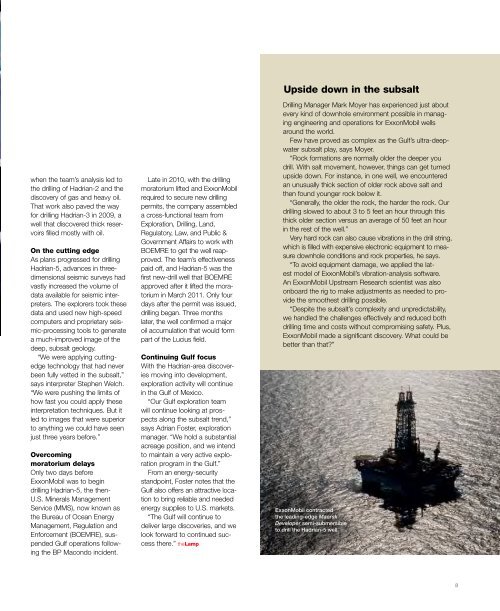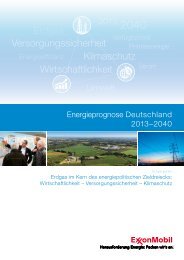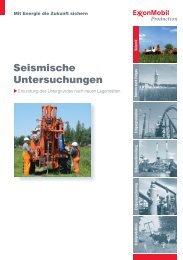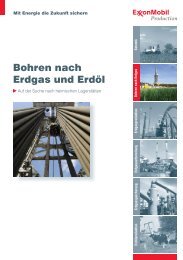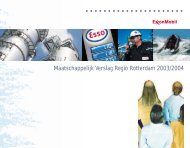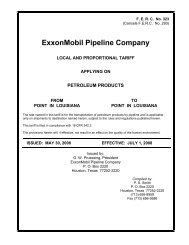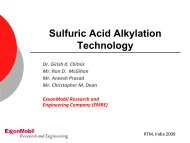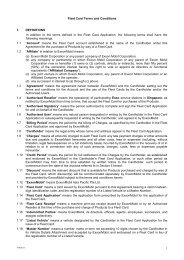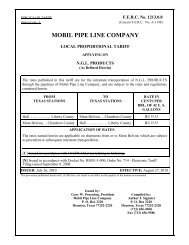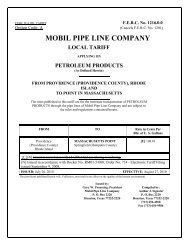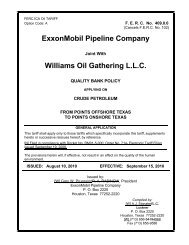Inside Papua New Guinea - ExxonMobil
Inside Papua New Guinea - ExxonMobil
Inside Papua New Guinea - ExxonMobil
You also want an ePaper? Increase the reach of your titles
YUMPU automatically turns print PDFs into web optimized ePapers that Google loves.
when the team’s analysis led to<br />
the drilling of Hadrian-2 and the<br />
discovery of gas and heavy oil.<br />
That work also paved the way<br />
for drilling Hadrian-3 in 2009, a<br />
well that discovered thick reservoirs<br />
filled mostly with oil.<br />
On the cutting edge<br />
As plans progressed for drilling<br />
Hadrian-5, advances in threedimensional<br />
seismic surveys had<br />
vastly increased the volume of<br />
data available for seismic interpreters.<br />
The explorers took these<br />
data and used new high-speed<br />
computers and proprietary seismic-processing<br />
tools to generate<br />
a much-improved image of the<br />
deep, subsalt geology.<br />
“We were applying cuttingedge<br />
technology that had never<br />
been fully vetted in the subsalt,”<br />
says interpreter Stephen Welch.<br />
“We were pushing the limits of<br />
how fast you could apply these<br />
interpretation techniques. But it<br />
led to images that were superior<br />
to anything we could have seen<br />
just three years before.”<br />
Overcoming<br />
moratorium delays<br />
Only two days before<br />
<strong>ExxonMobil</strong> was to begin<br />
drilling Hadrian-5, the then-<br />
U.S. Minerals Management<br />
Service (MMS), now known as<br />
the Bureau of Ocean Energy<br />
Management, Regulation and<br />
Enforcement (BOEMRE), suspended<br />
Gulf operations following<br />
the BP Macondo incident.<br />
Late in 2010, with the drilling<br />
moratorium lifted and <strong>ExxonMobil</strong><br />
required to secure new drilling<br />
permits, the company assembled<br />
a cross-functional team from<br />
Exploration, Drilling, Land,<br />
Regulatory, Law, and Public &<br />
Government Affairs to work with<br />
BOEMRE to get the well reapproved.<br />
The team’s effectiveness<br />
paid off, and Hadrian-5 was the<br />
first new-drill well that BOEMRE<br />
approved after it lifted the moratorium<br />
in March 2011. Only four<br />
days after the permit was issued,<br />
drilling began. Three months<br />
later, the well confirmed a major<br />
oil accumulation that would form<br />
part of the Lucius field.<br />
Continuing Gulf focus<br />
With the Hadrian-area discoveries<br />
moving into development,<br />
exploration activity will continue<br />
in the Gulf of Mexico.<br />
“Our Gulf exploration team<br />
will continue looking at prospects<br />
along the subsalt trend,”<br />
says Adrian Foster, exploration<br />
manager. “We hold a substantial<br />
acreage position, and we intend<br />
to maintain a very active exploration<br />
program in the Gulf.”<br />
From an energy-security<br />
standpoint, Foster notes that the<br />
Gulf also offers an attractive location<br />
to bring reliable and needed<br />
energy supplies to U.S. markets.<br />
“The Gulf will continue to<br />
deliver large discoveries, and we<br />
look forward to continued success<br />
there.” the Lamp<br />
Upside down in the subsalt<br />
Drilling Manager Mark Moyer has experienced just about<br />
every kind of downhole environment possible in managing<br />
engineering and operations for <strong>ExxonMobil</strong> wells<br />
around the world.<br />
Few have proved as complex as the Gulf’s ultra-deepwater<br />
subsalt play, says Moyer.<br />
“Rock formations are normally older the deeper you<br />
drill. With salt movement, however, things can get turned<br />
upside down. For instance, in one well, we encountered<br />
an unusually thick section of older rock above salt and<br />
then found younger rock below it.<br />
“Generally, the older the rock, the harder the rock. Our<br />
drilling slowed to about 3 to 5 feet an hour through this<br />
thick older section versus an average of 50 feet an hour<br />
in the rest of the well.”<br />
Very hard rock can also cause vibrations in the drill string,<br />
which is filled with expensive electronic equipment to measure<br />
downhole conditions and rock properties, he says.<br />
“To avoid equipment damage, we applied the latest<br />
model of <strong>ExxonMobil</strong>’s vibration-analysis software.<br />
An <strong>ExxonMobil</strong> Upstream Research scientist was also<br />
onboard the rig to make adjustments as needed to provide<br />
the smoothest drilling possible.<br />
“Despite the subsalt’s complexity and unpredictability,<br />
we handled the challenges effectively and reduced both<br />
drilling time and costs without compromising safety. Plus,<br />
<strong>ExxonMobil</strong> made a significant discovery. What could be<br />
better than that?”<br />
<strong>ExxonMobil</strong> contracted<br />
the leading-edge Maersk<br />
Developer semi-submersible<br />
to drill the Hadrian-5 well.<br />
8


